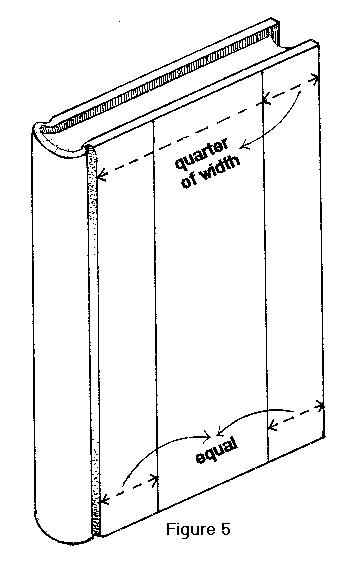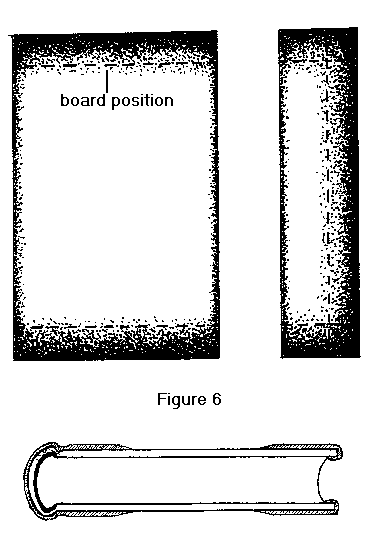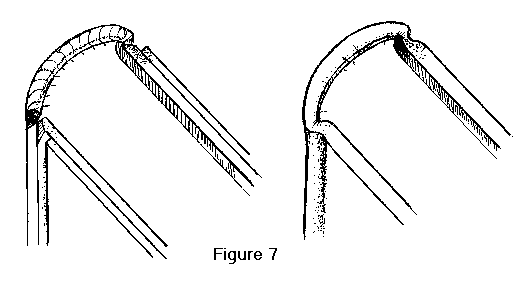
Volume 9 - Spring 2000
Good Books, Sound Binding - Part 2
by Arthur W. Johnson
These were prepared from two equal millboards that when combined would be the correct thickness for the binding. Cut larger than required, one was glued for two thirds of its width and on this the second board was placed 3 to 6 mm from its edge. The two are nipped in the press and become a 'split board' with an opening for the tapes. A heavier inner board is recommended for weightier volumes. Boards were cut square and to size by positioning flush with the joint and marking 'generous' squares at head, tail and foredge. This innovative board construction had recently been attributed to T. Harrison and was named after him. This simple and effective idea meant that the full thickness of leather could be used as the hinge whilst the inner board would support the book when standing on the shelf. It became known as the 'semi French groove'. See figure 4.
Attachment of boards
Boards were placed against the joints and indicator marks made for repositioning. On the inside of the split, both boards were glued, lined up to the marks and the tapes eased between the boards before nipping in the press. If the tapes are first glued to a strip of paper it will hold them rigid while they are inserted in the split.
Linings
Each book was given a tight back for strength and as spines had to be flexible, linings were kept to a minimum. The average book was lined with a pasted strip of morocco only, whilst heavier books were lined first with archival cloth and then with leather. Raised cord books were lined in similar fashion but the strip was cut in smaller pieces and each modelled over the bands using band nippers to make it secure. The leather on the spine was carefully sandpapered to eliminate all unevenness.
 Leather
and preparation for covering
Leather
and preparation for covering
The books were to be half bound for economy but a foredge strip was thought to be more practical than the conventional corners. Proportions were decided as figure 5. Some paring was inevitable especially at the turn-in at the head and tail and the edges of the boards. The thickness of the leather ensured that the centre of the board was not scuffed by contact with a surface. See figure 6. Board edges were 'softened' and the corners slightly rounded with sandpaper. The inner corners of the boards were 'back cornered'. Refer back to figure 4.
Headbands
The conventional embroidered headband was omitted as it was an expense and inadequate to support the spine when standing. Instead corded linen or cotton string, equal in width to the depth of the square, was inserted in the head cap. See figure 7.
Covering
This followed the usual procedure for smooth and raised cord spines with tight backs. The foredge strips were pasted and positioned and mitred at the corners with a paring knife before they were turned in. The leather was pushed into the groove with a folder and the board joints set on the inside. The book was tied up with thin cotton string positioned by the back cornered boards, enabling the head caps to be formed. Some buffer salts are washed out of the leather by paste and water so immediately after covering, the leather was swabbed with a solution of 8% potassium lactate plus 0.25% paranitrophenol as a fungicide and left to dry.
Opening
The book was placed flat on the bench and the top board eased up and down gradually increasing the arc until the cover swung freely. The other board was treated similarly. With both boards fiat and the text block held vertical a few sections were taken from each side and gently pressed down to ease the spine. This was done until the centre was reached and the process repeated.
 Trimming
Trimming
The margins of the leather on the outside were trimmed evenly.
Siding
Artificially grained and embossed cloths were not used although the bindings were made attractive using a harmonious choice of cloth, paper and coloured leathers. Small books were sided with thin bookcloth or marbled paper. Medium sized bindings were sided with bookcloth and heavier volumes with buckram. The materials were glued in position to seal down the edges of the leather by 2mm.
The Cloth Joint
The waste sheet protecting the endpapers was removed and with the board resting on the bench the cloth joint was glued and modelled securely into the joint and onto the board.
Filling in
The turn-ins of cloth and leather were trimmed evenly and the remaining blank part of the board filled in with an acid free manilla or similar card that was glued down.
Doublures
A single sheet of the same colour as the flyleaves was pasted down leaving an even and reasonable margin. The 'pull' of a half binding does not warp the cover, therefore the doublure is generally sufficient to control the board.
 Finishing
Finishing
To make the binding attractive yet still practical there was a concession in the finishing. The spine, similar to raised cord work, was marked into six compartments. The length of the back was measured, deducting 3mm from the head and 6mm from the tail. The remainder was divided into six spaces and separating lines tooled in blind across the spine. The extra 'weight' of space at the bottom gives stability. The top space was left blank, the second for the title, the third for the author and the fourth for the date. The identification of the book, known as the 'press mark' was tooled in the fifth space whist the sixth contained the name of the library. Lettering was in gold except when blind tooling could be used effectively on lighter leathers.
Dressing
In order to preserve the leather, lanolin dressing was rubbed sparingly over the cover.
Summary
Apart from a craftsman built ledger book the binding described is the most durable style of hand-work. The construction is designed for library use or for any purpose where strength rather than appearance is required. The materials are sound and acid free and the leather is treated to withstand pollution. Its strength lies in the use of morocco instead of calf, tape and not cord, the tight back and the semi French groove. Reinforced endpapers further strengthened the hinges of unpared leather. The leather strip prevents wear at the foredge and the substantial headcaps support the spine when the book is stored on the shelf.
After fifty years of use in the reference section the books were examined and the librarian is delighted. The bindings showed no evidence of breakdown but there was some scuffing along the bottom edges. In two of the books the cloth had rolled away from the edges of the leather and this could have been the result of inefficient gluing and rubbing down. However paper backed cloth had been used and the two layers had separated over the years. Marbled paper on the sides had become part of the board but were a little rubbed and faded.
There are occasions when enduring literature is ignored in favour of its covering. Bindings are not necessarily a means of expressing design creativity although there is much satisfaction in the work. The true craft of bookbinding is to preserve the contents and the glitter of gold and the brilliance of colours add nothing to the life of a book.
Arthur W. Johnson A.T.D., N.D.D. - was born in 1920. As well as holding an Art Teacher's Diploma and a National Diploma in Design he is also an Honary Fellow of both the Institute of Craft Education and Designer Bookbinders. Arthur has held teaching posts at Hornsey College of Art, Hammersmith School of Art, Willesden College of Art and the London College of Printing. He retired from teaching several years ago. He has also lectured extensively in England, Canada and New Zealand. His work has included Calligraphy, Fine Binding and Antiquarian Book Restoration and his bindings can be found in many public and private collections, including the British Museum. His excellent book, the Manual of Bookbinding by Thames & Hudson is considered as one of the foremost reference works for bookbinders and is recommended as essential reading by many teachers of bookbinding. He has written two other books which were also published by Thames & Hudson, A Practical Guide to Bookbinding and Book Repair and Conservation and Lettering on Books, published by Puiri Press, New Zealand.
